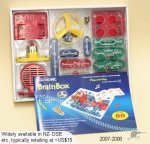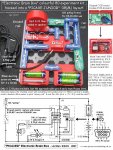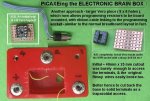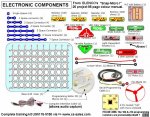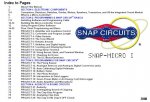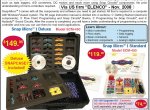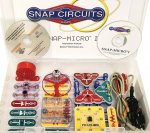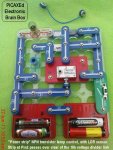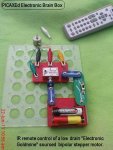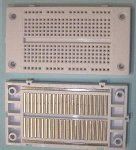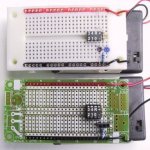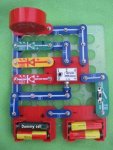I rustled this up ~early 2007 & had then put aside, but a local NZ school has just fired on the idea. Predictably they now want a set ASAP & don't have a technician...
Us old hands maybe forget how hard intro. electronics can be for clunky handed kids, with even breadboards initially beyond most. And don't get me started on the MONTHS it takes to become a competent hand solderer... Naturally harassed teachers,some of whom have been "persuaded" to take on electronics (instead of detention duties &/or bus queues etc!),may also find fiddly electronics resources a classroom management nightmare. "OK-who put the 555 pin side up on Jimmy's chair for him to sit on" etc. Even at tertiary level perfectly good & "precious" components are often just discarded by students- I well recall ~2001 rescuing near invisible white LEDs (then ~US$5 each) from under lab. benches & rubbish bins...
Anyway -these "80 in 1" Electronic Brain Box kits sell for as low as US$15,with the large & colourful parts an educators (& bored students) dream. No tools or specialised facilities are needed, as each part is designed for easy and quick assembly (& DISASSEMBLY!),with the colourful components connecting together with reliable press-studs. The manual is particularly lucid as well.
However there's really only an hour of flashing lights, whirling propellers & "machine gun/police sirens" before maxing out the smallest kit's possibilities. Voila - hence the PICAXEd version, still allowing electrotech. basics but now enhanced for intro. microcontrollers! Only PINs 1,2 & 4 are readily available, but PIN 3 is limited anyway. Of course SERTXD can still allow editing PC "F8" data viewing via the normal Rev.Ed programming cable.
I may write this up as an Instructable/SiChip article,detailing the fiddly COB (Chip On Board) => 08M hack, but can folks in UK/Oz etc first please let me know the availability & prices of these EBB kits locally. Dick Smith Electronics (DSE) still handle them here in NZ (as kit K 9150), although DSE Oz. doesn't seem to. I believe the CSIRO shop in NSW stocks a larger version however => http://www.csiroshop.com/search?text=brain+box . TIA - Stan
Us old hands maybe forget how hard intro. electronics can be for clunky handed kids, with even breadboards initially beyond most. And don't get me started on the MONTHS it takes to become a competent hand solderer... Naturally harassed teachers,some of whom have been "persuaded" to take on electronics (instead of detention duties &/or bus queues etc!),may also find fiddly electronics resources a classroom management nightmare. "OK-who put the 555 pin side up on Jimmy's chair for him to sit on" etc. Even at tertiary level perfectly good & "precious" components are often just discarded by students- I well recall ~2001 rescuing near invisible white LEDs (then ~US$5 each) from under lab. benches & rubbish bins...
Anyway -these "80 in 1" Electronic Brain Box kits sell for as low as US$15,with the large & colourful parts an educators (& bored students) dream. No tools or specialised facilities are needed, as each part is designed for easy and quick assembly (& DISASSEMBLY!),with the colourful components connecting together with reliable press-studs. The manual is particularly lucid as well.
However there's really only an hour of flashing lights, whirling propellers & "machine gun/police sirens" before maxing out the smallest kit's possibilities. Voila - hence the PICAXEd version, still allowing electrotech. basics but now enhanced for intro. microcontrollers! Only PINs 1,2 & 4 are readily available, but PIN 3 is limited anyway. Of course SERTXD can still allow editing PC "F8" data viewing via the normal Rev.Ed programming cable.
I may write this up as an Instructable/SiChip article,detailing the fiddly COB (Chip On Board) => 08M hack, but can folks in UK/Oz etc first please let me know the availability & prices of these EBB kits locally. Dick Smith Electronics (DSE) still handle them here in NZ (as kit K 9150), although DSE Oz. doesn't seem to. I believe the CSIRO shop in NSW stocks a larger version however => http://www.csiroshop.com/search?text=brain+box . TIA - Stan
Attachments
-
43.8 KB Views: 301
-
218.8 KB Views: 324
Last edited:

